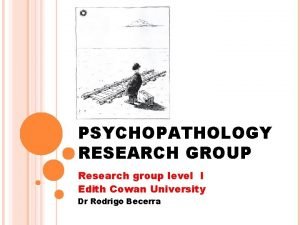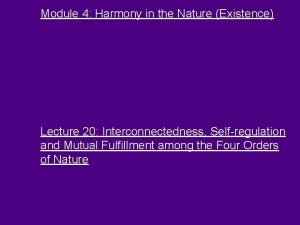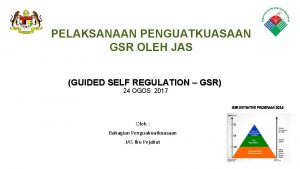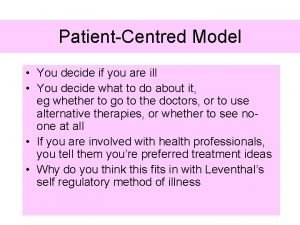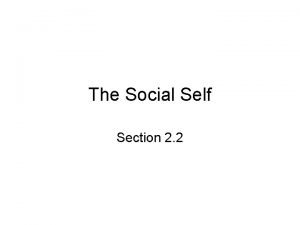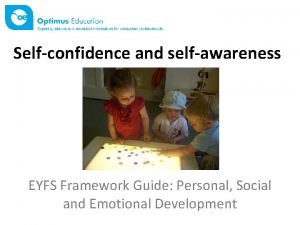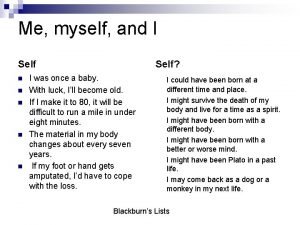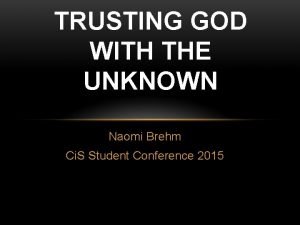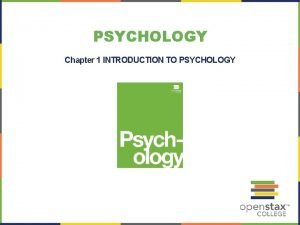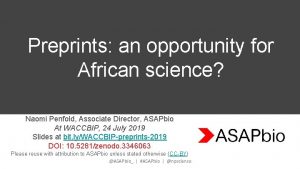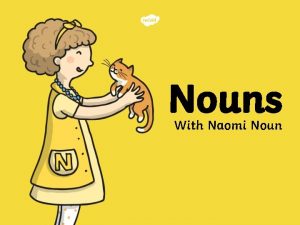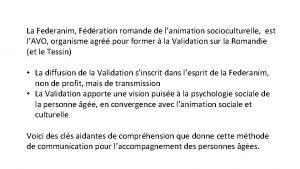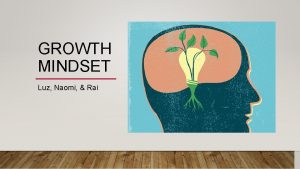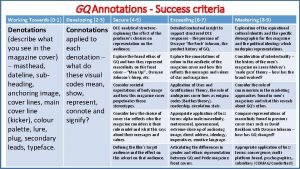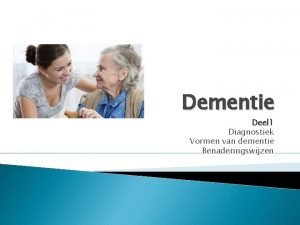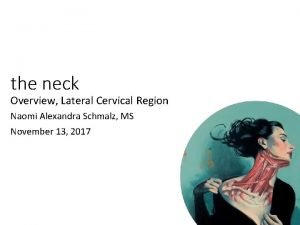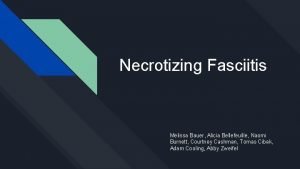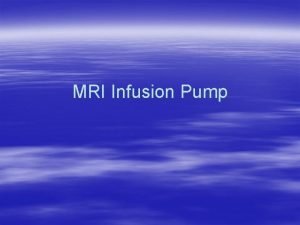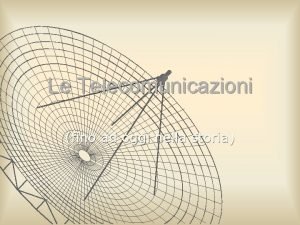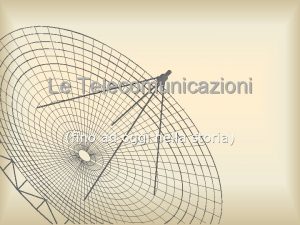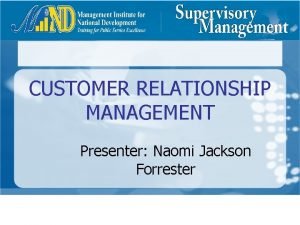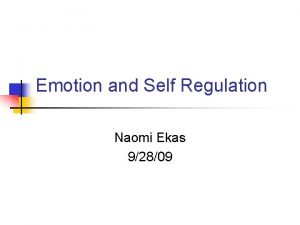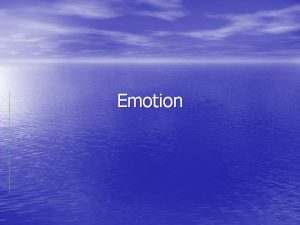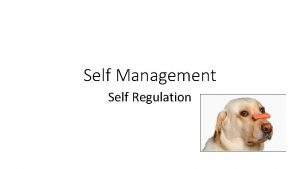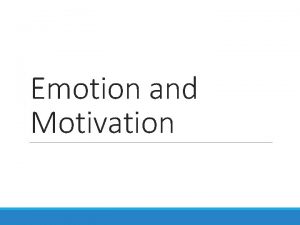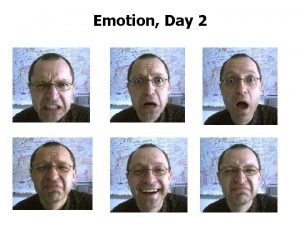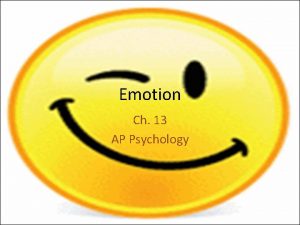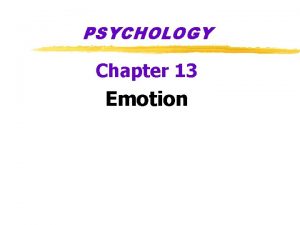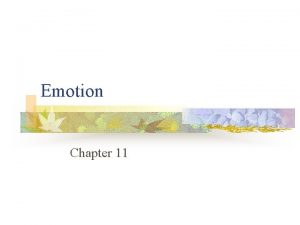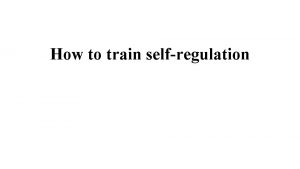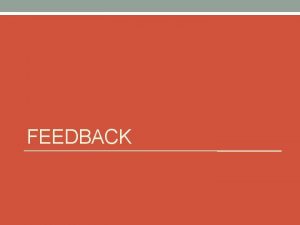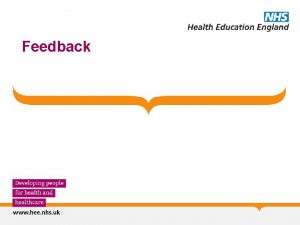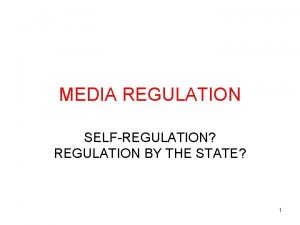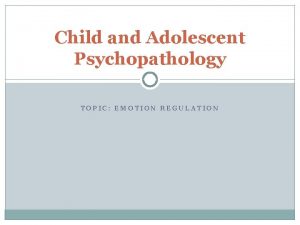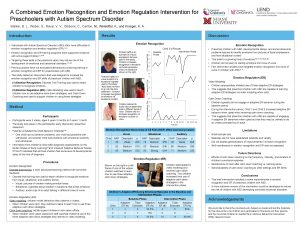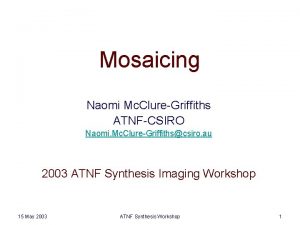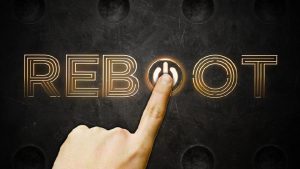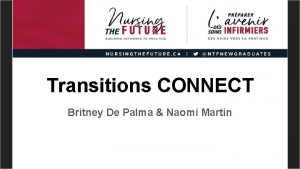Emotion and Self Regulation Naomi Ekas 92809 SelfRegulation






























- Slides: 30

Emotion and Self Regulation Naomi Ekas 9/28/09

Self-Regulation n n Children do not come into this world with all of the skills necessary to regulate their behavior It is around 2 years that we really start to see children monitoring behavior

Self-Regulation n Ability to comply with a request, initiate and cease activities according to situational demands, to modulate the intensity, frequency, and duration of verbal and motor acts in social and educational settings, to postpone acting upon a desired object/goal, and to generate socially approved behavior in the absence of external monitors (Kopp, 1982)

Self-Regulation n Neurophysiological modulation n n Birth to 2 -3 months Reflexes

Self-Regulation n Sensorimotor modulation n 3 months - 9 months + Engage in voluntary motor acts (reach & grab, hand to mouth, etc. ) and change that act in response to environmental demands No awareness of meaning of situation

Self-Regulation n Control n n n 9 -12 months to 18 + months Emerging ability of children to show awareness of social or task demands and modulate behavior/emotions E. g. compliance to demands

Self-Regulation n Emergence of self-control and the progression to self-regulation n n 24 + months Compliance, delay an act on request Representational thinking and recall memory Limited flexibility

Self-Regulation n Self-regulation n n 36 + months Flexibility!!!

Emotion Regulation n n In addition to regulating behaviors, children must also regulate emotional experiences Development of emotion regulation abilities follows Kopp’s description of emergence of self-regulation n Reflexes to flexible management

Emotion Regulation n Emotion regulation consists of the extrinsic and intrinsic processes responsible for monitoring, evaluating, and modifying emotional reactions, especially their intensive and temporal features, to accomplish one’s goals

Emotion Regulation n Monitoring, evaluating, modifying n n Not only negative emotions Not only dampening emotions, but also increasing

Emotion Regulation n Extrinsic influences n n n Parents!!! Critical in the early months Intrinsic influences n temperament

Emotion Regulation n Intensive and temporal features n n Intensity - subdue or enhance Speed or slow onset or recovery Reduce or increase lability (range) Limit or enhance persistence over time

Emotion Regulation n Accomplish one’s goals n n Must be regarded functionally What are regulator’s goals for that situation?

Emotion Regulation n What is regulated? n Control of underlying arousal processes through maturing systems of neurophysiological regulation n Diffuse excitatory processes decline in lability during first year Cortical inhibitory controls emerge gradually during infancy Nervous system reactivity

Emotion Regulation n Attention processes n Emotion can be regulated by managing the intake of emotionally arousing information n n Redirecting attention As they get older can do things like internal redirection of attention (e. g. thinking of something pleasant during unpleasant situation)

Emotion Regulation n Other components of information processing n Alter interpretations n n “He didn’t really die, he just got frightened and ran away” “It’s just pretend”

Emotion Regulation n n Increase access to coping resources Regulating emotional demands of familiar situations

Emotion Regulation n Importance of social interaction n Others can help regulate our emotions (e. g. mothers soothing young infant) n n n Importance of attachment relationship Others can help us with our interpretations of situations Modeling behavior of those around us

Emotion Regulation n Individual differences n n Temperament Attachment Parenting Others? ? ?

Emotion Regulation n Problems with the construct and research area

Emotion regulation… • …viable scientific construct? • …proposes to account for how and why emotions • organize, facilitate other physiological processes (e. g. , promote problem solving) – and/or • have detrimental effects (harm relationships) • …integrates an understanding of typical and atypical development – emotions relate to cognition and behavior --> developmental outcomes Fernandez

• Concerns – Use the term without a definition • define emotion & emotion regulation – Do not distinguish between emotion and emotion regulation • emotions are inherently regulatory • physiological systems aren’t clearly distinct from emotions – Use valence to provide information about emotion regulation without evidence of regulatory process • regulating & regulated • intra/interdomain – Optimal functioning only or includes maladaptive regulation – Emotions understood in context Fernandez

• Areas of Research – Infant Temperament • Reactivity (speed & intensity of initial activity) • Self-regulation (ability to modify the intensity & duration by engaging in behavioral strategies) – Mother-Child Interactions • regulated and regulating in social interactions • quality of emotional exchanges related to child’s ability to regulate own behavior – Early Emotional Self-Regulation • emergence of new (more complex) use of objects and interactions (ages 2 -4) • manner of self-regulation is predictive of later outcomes Fernandez

• Direction for New Research – Independent measures of emotion & regulation • Avoid confounding valence with regulation • Use of multiple measures – Analysis of temporal relations between emotion & regulation • Demonstration of change over time – Comparison of emotion & regulation in contrasting conditions • Help the researcher infer emotion when its barely detectible • Disentangle activation of emotion & regulatory process – Multiple converging measures • Self-report, expressive behavior, and physiological change • Heightens inferencing Fernandez

Feldman, R. (2009). The development of regulatory functions from birth to 5 years: Insights from premature infants. Child Development, 80(2), 544 -561. n Different perspectives of regulation n n Common assumptions n n Posner & Rothbart (1998) – interplay of b/mechanisms of excitation and inhibition Calkins & Fox (2002) – integration of physiological, emo, attn, cog processes Neuroscience – relations b/ brainstem, limbic, and cortex to produce behavior Fogel (1993) – coregulatory function of early relationships Integrated , hierarchically ordered system of multiple components of functioning Synchronized in time Plastic interplay b/ coregulated and autoregulated processes in development Hierarchical-integrative course of regulation development n 1 st year: Emotion regulation of external and internal stresses n 2 nd n n n Based in brain-stem function (sleep-wake cycle, vagal tone) year: Attention regulation to achieve goals Based in both physiological and emotional regulation processes Preschool years: Self-regulation of behavior and cognition n Behavior adaptation, Executive functions, Conscience

Current Study Premature infants from birth to 5 yrs n Difficulties in physiological and behavioral regulation Brainstem Limbic Cortex Core Systems 32 wks Neonate Physiological oscillators Emotion regulation 3 mos 6 mos 12 mos Attention regulation Self-regulation Goals 1) Describe expression of multiple regulatory processes in at-risk pop 2) Describe longitudinal pattern of associations across levels - Unique and interactive effects of levels 1 -3 on 4 3) Test causal paths to self-regulation - Vagal tone Attn regulation & behavior adaptation - Sleep-wake cyclicity Attn regulation 24 mos 5 yrs

Current Study n High vs. Low Medical Risk n n n Correlations between levels of regulation n n Mild – moderate correlations among levels Predicting self-regulation at age 5 n n n Neonates: less organized sleep-wake cycle, higher neg emotion (boys also at risk) 1 year: worse emotion reg, higher neg emotion 2 years: worse attn reg 5 years: poorer EF, no differences in behavior adaptation or self-restraint Vagal tone, sleep-wake, emo reg, attn reg predicted EF All but sleep-wake predicted behavior problems & self-restraint Structural modeling

Results & conclusions n High vs. Low Medical Risk n n n Neonates: less organized sleep-wake cycle, higher neg emotion (boys also at risk) 1 year: worse emotion reg, higher neg emotion 2 years: worse attn reg at 12 but not 24 mos, worse delayed response at 24 mos 5 years: poorer EF only, no differences in behavior adaptation or self-restraint Vulnerability but effects diminish over time due to other protective factors Correlations between & within levels of regulation n n Mild – moderate correlations between levels Regulation construct is continuous across time Physiological measures capture basic feature of orientation to environment Most variance not shared – suggests malleability in development Consistent relationship between low neg emotionality and regulatory functions (e. g. sleep-wake cyclicity & less cry states) Bidirectional influence between development of negative affect and regulatory functions Reactivity Regulation Reactivity Environmental stressors Fuccillo Negative Emotionalit y Regulation

Results & conclusions (cont. ) • Predicting self-regulation at age 5 n Structural model Sig better fit when indirect paths included Consistent with hierarchical-integrative model of brain maturation n n Unanswered questions n n Physiological & emotional regulatory processes across time Need for person-centered analysis & study of predictors of resilience Fuccillo
 Erfa 09
Erfa 09 Gesund arbeiten am pc
Gesund arbeiten am pc Difficulty in emotion regulation scale
Difficulty in emotion regulation scale Example of an ideal self
Example of an ideal self Recyclability and self regulation in nature
Recyclability and self regulation in nature Guided self regulation
Guided self regulation Decide model
Decide model I self and me self difference
I self and me self difference Eyfs
Eyfs Me myself and i self concept
Me myself and i self concept Trusting god with the unknown
Trusting god with the unknown Openstax
Openstax Naomi penfold
Naomi penfold Naomi noun
Naomi noun Les 4 phases de la résolution naomi feil
Les 4 phases de la résolution naomi feil Naomi rai
Naomi rai Pride magazine naomie harris analysis
Pride magazine naomie harris analysis Validation dementie
Validation dementie Valentine for ernest mann by naomi shihab nye
Valentine for ernest mann by naomi shihab nye Naomi navarro
Naomi navarro External occipital protuberance
External occipital protuberance Stephen king facts
Stephen king facts Naomi jackson georgia
Naomi jackson georgia Naomi burnett
Naomi burnett Naomi chesler
Naomi chesler Making a fist by naomi shihab nye analysis
Making a fist by naomi shihab nye analysis Naomi conzo
Naomi conzo Naomi conzo
Naomi conzo Naomi burger
Naomi burger Naomi jackson alabama
Naomi jackson alabama Naomi latorraca
Naomi latorraca


